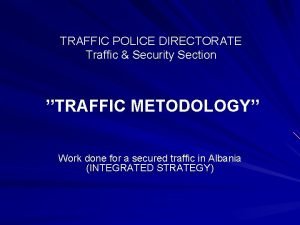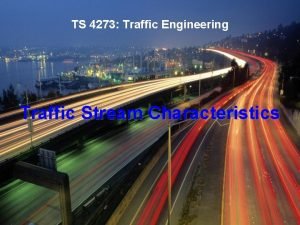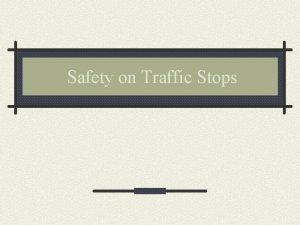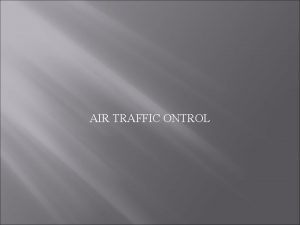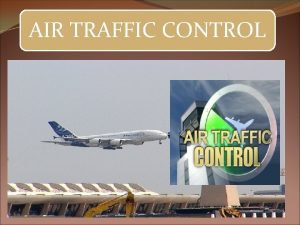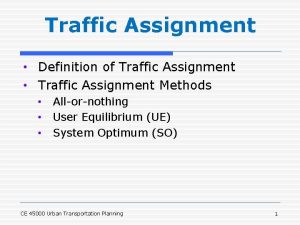HSE Requirements for Site Traffic HSE GROUP RULE










- Slides: 10

HSE Requirements for Site Traffic HSE GROUP RULE (CR-GR-HSE-418) SUMMARY This rule defines the minimum HSE requirements for the management of risks related to site traffic for vehicles, motorised machines, and pedestrians inside sites operated by Group entities or affiliates, existing or as a project, including buildings, parking lots and work sites. This rule does not cover aspects specific to loading / unloading (CR-GR-HSE-431) and lifting operations (CR-GR-HSE-420).

CR-GR-HSE-418 q Context: in the 2008 -2018 period, for the Group, 3% of fatalities (3) and HIPOs (46) at the workplace are linked to traffic on site. Scope: all entities of the operated domain q Scope: inside sites operated by Group entities or affiliates, existing or as a project, including buildings, parking lots and work sites. q 7 main requirements plus 3 appendices which define the more specific requirements concerning: ü ü ü Minimum Provisions to Establish Site Traffic Rules (excluding service stations in operation) Minimum Provisions for Drivers of Vehicles and Motorised Machines Circulating on Site (excluding public vehicles at service stations and vehicles only accessing car parks) Minimum Safety Provisions for Vehicles or Motorised Machines and Their Use on Site (excluding public vehicles at service stations and vehicles only accessing car parks) q Replacing / modifying branch document : ü ü ü CR-RC-HSE-008 - Sécurité de la conduite automobile et règles de circulation CR-MS-HSE-201 - General safety rules - § 7 CR-EP-LSO-061 – Vehicle and driving (already removed) q Date of publication in REFLEX: 30/09/2020 q Effective date: 9 months after publication

REQUIREMENTS Requirement 3. 1. 1 : Risk Identification and Analysis of Site Traffic { W NE The identification and analysis of risks related to site traffic are carried out. They take into account, as a minimum: § The different types of transport and means of moving around on site; § The technical characteristics of vehicles and motorised machines; § General and specific traffic rules of the site; § Roadways and any potential restrictions (e. g. size, dimensions or weight of the vehicles and motorised machines); § Passage frequencies; § Accident history and relevant return on experience (REX). § They are reviewed regularly and after modification (temporary or permanent) of one or more of the elements mentioned above. New requirement for all branches (systematic risk analysis not formalised in existing CR) Requirement 3. 1. 2 : Identification of Risk Control Measures { W NE Based on the results of the risk analysis, risk control measures are implemented in order to: § Reduce, to the extent possible, the number of vehicles authorised to circulate on site; § Optimise the traffic flow (in particular, by reducing the number of crossings and the travel distance); § Protect the parts of the installations exposed to risks; § Define rules concerning the types and zones used by vehicles and motorised machines. New requirement for all branches (formalisation of the risk analysis process) 3

REQUIREMENTS Requirement 3. 1. 3 : Site Traffic Plan and Rules { The traffic plan and rules are defined, taking into account the risk analysis and the identified risk control measures. As a minimum, the provisions provided in Appendix 1 and 2 are taken into account to establish site traffic rules. The site traffic plan is implemented in a visible and comprehensible manner. EP, GRP: new requirement Appendix 1: Minimum General Provisions for Site Traffic { Ø Local traffic regulations are applicable (MS, GRP : new requirement ) Ø Only authorised vehicles can access the site (excluding unenclosed, exterior parking lots). Private vehicles are not allowed to circulate on site, NEW Ø The separation between motorised vehicle roadways and pedestrian or bicycle roadways is prioritised, and the number of crossings is minimised NEW Ø Roadways with high pedestrian flow are, as a minimum, demarcated or identified by ground markings (EP, GRP, RC: new requirement ) Ø Speed limits are defined and cannot exceed: (GRP, EP: new requirement. For MS the actual limit is fixed at 25 km/h) • 30 km/h (18 miles/h) on free roadways (excluding roads connecting separate sites); and • 10 km/h (6 miles/h) on regulated roadways subject to authorisation as well as in work areas and zones where pedestrians are present. Ø The seat belt is fastened by all occupants when the vehicle or motorised machine is in motion NEW (l’exigence s’applique aussi aux engins) ; Ø The use of radio link systems, walkie-talkies (except listening mode) and/or mobile phones with or without hands-free devices (hands-free, Bluetooth, etc. ) while driving is prohibited (active use of radio link or walkie-talkies is permitted in emergency situation) (MS, GRP: new requirement) 4

REQUIREMENTS Appendix 1: Specific Provisions for Parking on Site { Ø Vehicles are parked exclusively in the spaces reserved for this purpose (GRP, EP, MS : new requirement ) Ø Vehicles and motorised machines are not parked in front of any building or production unit access, in front of access points and walkways, or near fire-fighting facilities (GRP, EP, MS : new requirement ). Ø Vehicles are parked in such a way that they can leave the parking space in a forward motion. When parked, the parking brake is activated (GRP : new requirement ) Ø Vehicles and motorised machines parked in a regulated roadway are not locked. Keys and any start codes are placed in a visible position (MS, GRP, EP : new requirement ) 5

REQUIREMENTS Appendix 1: Specific Provisions for Motorised Machines, Particularly Forklifts { Ø Motorised machines are not moved if their equipment is unsafe or deployed in an extended position NEW (l’exigence existe pour MS mais que pour les chariots). Ø Motorised machines are not moved if their equipment is unsafe or deployed in an extended position (RC, GRP, EP : new requirement ) Ø The speed of forklifts is limited to 12 km/h (7 miles/h). This speed is limited to 8 km/h (5 miles/h) in zones with mixed forklift and pedestrian traffic. Depending on the results of the risk analysis, lower speeds may be defined taking into account the environment (e. g. inside of a building/workshop) and the type of forklift used (RC, GRP, EP : new requirement ). Ø Lorsque le chariot élévateur est garé, le conducteur repose les fourches à plat au sol. Si cela n’est pas possible, les fourches sont levées à plus de 2 mètres du sol et sans charge (RC, GRP, EP : new requirement). Ø When the forklift is parked, the driver sets the two forks flat on the ground. If this is not possible, the forks are lifted more than 2 meters off the ground without a load (RC, GRP, EP : new requirement). Ø When visibility moving forward is poor due to the bulk of the load, the driver is guided by a “spotter” or moves the forklift in reverse. This type of manoeuvre is to be used as little as possible and for short distances only, by putting in place appropriate measures based on a risk analysis (such as spotters, driving assistance devices, etc. NEW Appendix 1: Provisions for Pedestrians and Cyclists { Ø Pedestrians use designated path/walkways and hold the handrail when taking the stairs NEW. Ø Personnel appointed as “spotter” or traffic assistants, pedestrians and cyclists having to move in or near busy traffic areas (e. g. loading/unloading zones, common forklift operating zones, pedestrian crossings in areas with a great number of vehicles and no physical separation of the road ways) are to wear high-visibility clothing NEW. Ø Personnel designated as "spotters" or traffic assistants are identifiable and can communicate effectively with the driver NEW. 6

REQUIREMENTS Appendix 2: Minimum Provisions for Drivers of Vehicles and Motorised Machines Circulating on Site (excluding public vehicles at service stations and vehicles only accessing car parks) { Drivers: § Perform a daily visual inspection of the general condition of the vehicles and motorised machines before they are used (or at shift change)) NEW § Carry only the number of authorised passengers (MS, GRP: new requirement ) § If transporting loads, ensure the loads are properly loaded and secured to prevent any load movement, tipping or dropping during movement NEW; § Ensure there are no loose objects in the cab likely to become a dangerous projectile in the event of an overturn or a sudden manoeuvre NEW 7

REQUIREMENTS Requirement 3. 1. 4 : Communication { General safety instructions, including the actions to be taken in the event of an incident or emergency (evacuation, muster points, etc. ), and the traffic plan and rules are communicated to all persons who have access to the site. EP, GRP: new requirement Requirement 3. 2. 1 : Authorisation for Driving Motorised Machines On Site { Drivers of motorised machines and in particular forklifts (with mounted drivers) are formally authorised by their employer to drive on the basis of: § Validation of medical fitness; § Training for the operation of the motorised machine; § Knowledge of the site's traffic rules. RC, EP, GRP: new requirement 8

REQUIREMENTS Requirement 3. 2. 2 : Safety Specifications and Maintenance of Vehicles and Motorised Machines { Vehicles and motorised machines used on site shall comply with the safety specifications in Appendix 3, as a minimum. They are regularly serviced and maintained in good working order. They are subject to a daily visual check of their general condition before being used for the first time by drivers and cyclists. In the event of a detected anomaly, the vehicle or motorised machine is removed from service and labelled until it is repaired. RC, EP, GRP: new requirement Requirement 3. 3. 1 : Roadway Maintenance { Roadways remain permanently unobstructed; if necessary, any obstacle is visibly marked and remains visible both night and day. Roadways and the implemented elements of the traffic plan are regularly inspected and maintained. EP, GRP : new requirement 9

REQUIREMENTS Appendix 3: Minimum Safety Provisions for Vehicles or Motorised Machines and Their Use on Site (excluding public vehicles at service stations and vehicles only accessing car parks) { § § § § 10 The authorised means for transport are vehicles or motorised machines with fixed driver protection (e. g. cabin, roll bar, ROPS) as well as bicycles without electric assistance. The use of other two-wheeled motorised vehicles is prohibited NEW. Any vehicle or motorised machine with a seated driver are equipped with safety belts. This applies to counterbalance lift trucks, for other types of forklift trucks with the operator's seat facing sideways, the possible absence of a belt is compensated by the implementation of organisational measures to limit the risk of collision NEW. Vehicles or motorised machines are equipped with driver protection structures according to the risk to which the driver is potentially exposed (FOPS, FGPS, etc. ). For forklift trucks, driver protection is mandatory when the maximum lifting height is more than 1. 8 m above the ground according to ISO 3691 -1 NEW The use of vehicles and motorised machines respects the instructions and operating procedures provided by the manufacturer and the regulatory obligations. No technical modifications may be made without the manufacturer's authorisation. NEW Vehicles or motorised machines with access to an area with a risk of explosion or fire are subject to a special authorisation that includes the applicable preventive measures which are defined by the entity or affiliate (MS, EP, GRP: new requirement). A person guiding the manoeuvres (“spotter” or traffic guide) and/or anti-collision systems (e. g. audible and/or visual warning devices automatically activated by the reverse gear engagement, pedestrian detection systems) are used when: • The driver of the vehicle or motorised machine is unable to perform the manoeuvre alone; • The area presents risks associated with the manoeuvre that may impact persons or equipment; or • It concerns the reverse of a heavy vehicle or collective transport of 9 or more persons. These systems are selected taking into account the intended conditions of use NEW. Bicycles are equipped with reflective elements NEW.
 Inbound traffic vs outbound traffic
Inbound traffic vs outbound traffic Intelligent traffic solutions
Intelligent traffic solutions Hot site cold site warm site disaster recovery
Hot site cold site warm site disaster recovery Formuö
Formuö Typiska drag för en novell
Typiska drag för en novell Tack för att ni lyssnade bild
Tack för att ni lyssnade bild Ekologiskt fotavtryck
Ekologiskt fotavtryck Varför kallas perioden 1918-1939 för mellankrigstiden?
Varför kallas perioden 1918-1939 för mellankrigstiden? En lathund för arbete med kontinuitetshantering
En lathund för arbete med kontinuitetshantering Särskild löneskatt för pensionskostnader
Särskild löneskatt för pensionskostnader Personlig tidbok fylla i
Personlig tidbok fylla i














